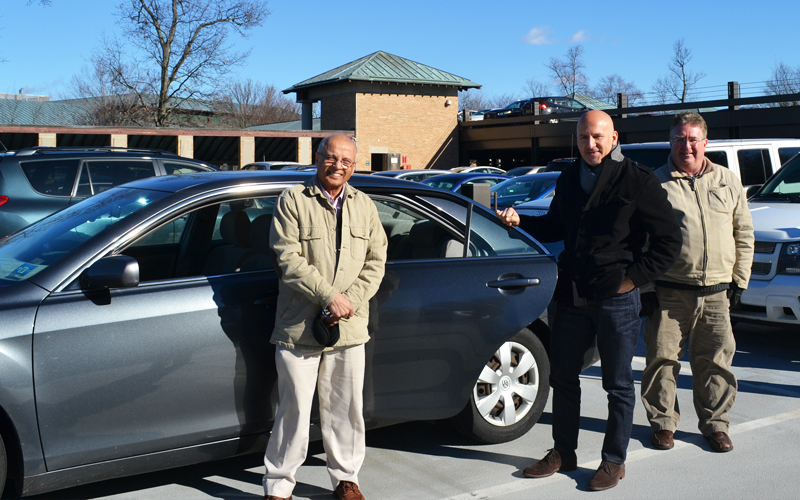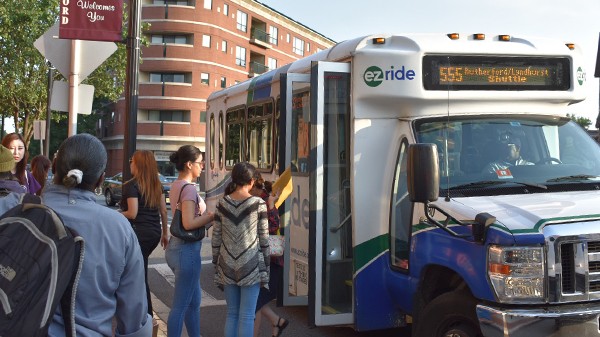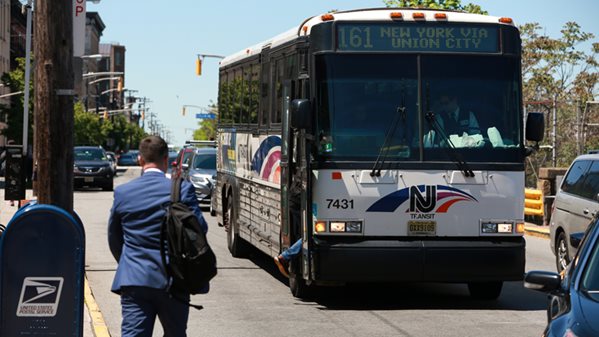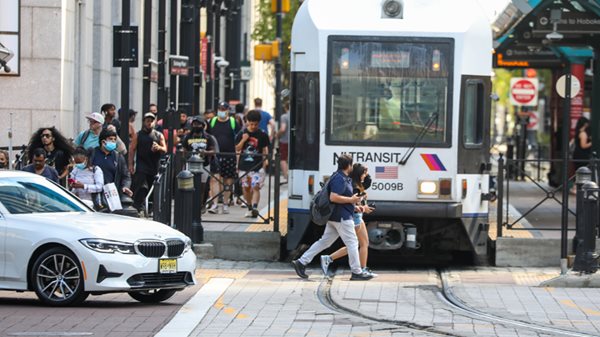
GETTING PEOPLE to give up driving alone to work has been the focus of a host of government programs for more than four decades. People have been cajoled with ads, offered incentives through their employers, given access to special highway lanes, and sometimes guilt-tripped about environmental impacts they’re causing—all to get them to take mass transit, share their ride through car or vanpools, walk or bike, or maybe stay home and telecommute at least a couple of days a week.
These approaches were having a modest effect, helping reduce congestion, lessen pollution, limit the need for infrastructure expansion and, when done right, improve worker satisfaction.
Then the pandemic hit and that telecommuting strategy for the first time became a truly mass phenomenon. Tens of millions of mostly white-collar workers stayed at home in front of their computers for months on end. Virtual work environments became the focus of major employers.
Overall, researchers at the Working From Home Research Project, created in May 2020 in response to the impact of COVID-19 on work environments, found that telework accounted for about 50 percent of paid work hours between April and December 2020 compared with 5 percent before the pandemic. Today, as of March 2024, the researchers find that more than 40 percent of people are engaged in some kind of remote work—29 percent hybrid, and 13 percent fully working from home, with considerable variation by region.1
Even as people have filtered back to in-person work, commuting remains forever changed. Though once part of a suite of strategies for improving transportation efficiency—called Transportation Demand Management (see sidebar)—telecommuting when adopted on a mass scale has introduced new inefficiencies and disruptions to transportation and economic activity. Government, employers and workers are still adapting to and addressing the changes.
Transportation Management Associations
In many regions of the country, organizations that have been at the forefront of efforts to promote more efficient commuting are confronting the new realities and seeking to adapt their services. These are transportation management associations (TMAs) which traditionally took a jack-of-all-trades approach to commuter services. This included running last-mile shuttles to and from train stations, helping match rides for those seeking car and van pools, working with employers to create trip reduction or transit pass benefit programs, and educating commuters about options.
Numbering up to 150 across the country, many TMAs got their start in the 1970s as part of efforts to reduce driving and gas consumption amid oil embargoes and a national energy crisis. According to Phillip Winter, Director of the Transportation Demand Management Program at the University of South Florida, carpooling reached its high point of 19.3 percent in 1980. Even at around 7.5 percent today (with up to half of carpools involving members of the same household), he notes, “millions of people nationally are still doing it.” Winter said TMAs in later years evolved to become “advocates for improved transportation of all types … [including] providing adequate and safe roadways and accommodating expanded transit service.”
The organizations are mostly non-profits; some are sponsored by or affiliated with local government or business improvement districts; others are members of regional planning agencies, which guide and assist their work.
Their hyperlocal approach to transportation means that “If you’ve seen one TMA, you’ve seen one TMA,” says Timothy Phelps, Executive Director of the TMA of Chester County, in Southeast Pennsylvania. Rob Henry, Executive Director of the neighboring Greater Valley Forge TMA, says the organizations “are always really good at finding where the gaps are [in local transportation] and coming in and helping fill them.”
Has the boom in telecommuting altered TMA commuter services? “Tremendously,” according to Krishna Murthy, Executive Director of the EZ Ride TMA in northern and central New Jersey. Prior to the pandemic, his organization worked with employers to create 45 vanpools; today he says they’re “in the single digits.” Similarly, shuttle ridership is down dramatically. “We’re lucky if we get 25 percent of pre-Covid ridership,” Murthy said. He doesn’t blame employers. With so many employees working from home full- or part-time, it doesn’t make “financial sense” for them to sponsor shared rides.

Changing Travel
The drop-off in daily commuting continues to disrupt bus and rail transit services that are the end or starting point of many TMA-supported shuttles or shared rides. While transit ridership has bounced back in New Jersey to a greater extent than in other parts of the country, it remains 10 percent or more below pre-pandemic numbers, weakening fare revenues.
Changing transit frequency and schedules to meet new demands leaves some transit commuters with fewer, less convenient options. That’s particularly a concern for transit-dependent, low-income workers, including many of the recently vaunted “essential workers” in hospitals, grocery stores, and warehouses who often work off-hour shifts or in outlying areas.
The reduced flow of commuters has brought depression to the office market in downtowns and severely harmed what New York City Mayor Eric Adams calls the urban “financial ecosystem” that includes restaurants, dry cleaners, office suppliers, and the like.
Meanwhile on the roadways, traffic patterns are changing in unpredictable ways. Many of those workers who once shared commutes are driving alone when they do go into work. They encounter new and changing patterns of congestion. For instance, traffic on main highways to the south and west of Philadelphia has returned to pre-pandemic levels but remains significantly reduced on other routes. Road safety remains a concern. While the spike in road fatalities that occurred early in the pandemic is gradually declining, AAA found that more than half of all drivers still engage in dangerous behavior.
For TMAs, the loss of the once predictable tides of commuting greatly complicates efforts to aggregate commutes for shared rides. Henry says in his area commuting has “definitely spread out” – on many days stretching to seven in the evening. Tuesdays through Thursdays, he says, normally see the most traffic but “it varies every single day depending upon things as simple as the weather.” That means that TMAs must adapt in innovative ways to address needs in a newly fragmented and uncertain commuting market, Murthy, of EZ Ride, said.
Regional Variation
The Washington, D.C. region has long had strong centralized commuting, with hundreds of thousands of federal workers traveling each day to agencies in the core downtown or to the Pentagon, just over the Potomac River in Virginia. Car and van pools made up about 5 percent of daily commutes in 2019. Many were formed through ride-matching and other services provided by the Commuter Connections program of the Metropolitan Washington Council of Governments (COG), in cooperation with several TMAs in the region.
But up to 20 percent of carpools on the road were informal affairs, formed through D.C.’s grassroots innovation, “slugging.” Thousands of commuters lined up each morning at designated locations where solo drivers could pick them up to gain the numbers needed to access high-occupancy vehicle lanes.
Obviously, with the pandemic, fear of contagion all but ended the practice, though, in 2022 slugging continued to register in small numbers in COG’s “State of the Commute” survey. That survey also found that solo driving increased 14 percent from 2019 to 2022, as car and van pools dropped from 5 to 2 percent and transit use slid as low as 50 percent on key lines.
 Ed Murray
Ed Murray
Push-Pull
The work policies of the gargantuan federal government have been driving the trends. In early 2023, George Washington University Professor Geoge Bailey estimated that on average only one in three federal employees were in the office and downtown D.C. was missing almost 200,000 daytime office workers.
Officials were alarmed. In August 2023, the White House called for Cabinet members to "aggressively execute" plans for federal employees to work more in their offices. This was supported by a letter to the Office of Management and Budget signed by the 23 local government executives serving on the COG. They were particularly concerned about the drop in ridership on rail, which they said is “difficult to efficiently operate … without predictable ridership spread across the work week.”
Countering this push are federal worker unions, which want to maintain and codify work from home policies in bargaining agreements with federal agencies. A similar push-pull over work policies extends to the private and non-profit sectors. The Metro COG survey found an increase in free parking being offered to downtown workers. According to NIck Ramfos, who until January headed the COG’s commuter efforts and is now at AASHTO, this is to “sweeten the pot” for workers to show up in person, but only adds to the woes for transit.
Such accommodations for remote work are now a common – even required – means to recruit and retain workers. Murthy said that for the first time he sees companies “bending over backwards to accommodate the needs of employees – and maybe that's a good thing.” Henry relates that one tech firm in southeast Pennsylvania’s Valley Forge area tried to bring its employees back to the office, but “they couldn't get anybody to come. So, they're 100 percent remote now. People still have their jobs; they just don't have a physical location anymore.”
TMAs themselves, as small non-profits with tight budgets, are being buffeted by the unsettled and competitive job market. Murthy finds it very difficult to hire and retain drivers and has 25 or more openings. That limits his ability to market and provide shuttle services to even the reduced pool of businesses who want them.
D.C. Messaging
The Washington, D.C. COG is forging ahead, attempting to rekindle interest and participation in car and van pools with a planned spring marketing campaign prepared with the help of an ad agency. The campaign will draw on a 2023 survey that found that workers are not particularly happy with their drive-alone commutes. While they view carpooling positively, most have never considered it for their own commutes.
Themes of the campaign will include asking commuters to start small with some changes to their commute, whether it's once a week or once a month; and emphasizing that sharing your commute is safe and affordable, Ramfos said.
But the campaign must contend with a pool of potential carpoolers who appear more wary than in the past about sharing rides with strangers. Three quarters of D.C. carpools in 2022 were composed of persons in the same family or household compared to just over half prior to the pandemic. The 2023 survey of commuters confirmed this preference for ride sharing within a familiar circle – family, friends, neighbors and colleagues of one‘s choosing.
The new wariness could well be behavioral fallout from decreased social interaction during the pandemic, reinforced by solitary remote work. Similar avoidance is seen in other areas of life. The New York Times in November 2023 reported that fast food drive-through traffic “rose 30 percent from 2019 to 2022. … Meanwhile, the number of people eating inside fast food restaurants in the first half of 2023 fell by 47 percent from the same period in 2019.”
Whatever the cause, it represents one more hurdle for TMAs in reviving shared rides and possibly for transit systems in closing the remaining gaps in ridership.
 Ed Murray
Ed Murray
Change in Focus
The need for adaptation has prompted EZ Ride, for its part, to look “Beyond the Journey to Work” – the title of its latest annual report. While still actively assisting a variety of employers, its fastest growing services help seniors and others arrange Uber and Lyft rides, mostly for medical appointments. It offers in-route assistance if problems arise.
The services are provided to local non-profits, including one that operates a low-income housing facility at the Jersey Shore, and to county agencies, supplementing their paratransit programs. Ridership through EZ Ride’s assistance has been doubling every year, Murthy said.
Other TMAs are helping explore on-demand services that can potentially better serve more fragmented and intermittent travel needs. In Chester and Montgomery counties, just outside Philadelphia, the two TMAs are working with the regional transit agency SEPTA to create the first of nine planned on-demand “microtransit” zones in the state’s suburban areas where traditional buses are not cost effective. Residents will use an app to summon a van or shuttle.
A bus line serving the City of Coatesville may soon be converted to on-demand microtransit in the off-hours, in part to better meet the non-standard schedules of service workers and those in “pick and pack” warehouses and similar area facilities.
According to Governing magazine, such microtransit is increasingly popular across the country but has its critics who “say it’s a far cry from the efficiency of mass transit, and a high cost for transit agencies that doesn’t generate any significant increase in overall ridership.” Still the services are becoming part of the arsenal of commuting tools used by TMAs.
Encouraging Walking and Biking
Perhaps the most widespread adaptations by TMAs involve ramping up efforts to promote and support walking and biking. These attempts were always part of transportation demand management strategies to get people out of their cars, at least for the shortest trips. In recent years, as local governments, businesses, and developers have taken up the cause of combatting climate change and creating more livable and walkable communities, TMAs have become a key ally on walking and biking.
In New Jersey, among the activities of the state’s eight TMAs this past year were: conducting pedestrian safety campaigns in conjunction with local police; working with towns to install temporary bike lanes and corner bump-outs as demonstration projects; assisting towns in creating and implementing Complete Streets policies; conducting bike rodeos and safety classes in schools; offering instruction on how to ride e-scooters; participating in Road Safety Audits; providing bike safety equipment to underserved communities, and more.
These activities are taking on greater importance as the number of local trips is increasing. “Traffic at mid-day can be worse than traditional A.M.-P.M. congestion because you have people just making all these little side trips that they weren’t making before,” Henry said. Many of those trips likely could be made walking or biking with the right incentives, policies and infrastructure put in place, which is a growing focus of many TMAs.
TMAs are also involved in supporting micromobility options—scooters, e-bikes, and bike shares—which have burgeoned in popularity since the pandemic and in helping site electric vehicle charging stations.
In some areas, an influx of new residents is adding to local trips. In 2022, almost a third of remote workers moved, compared to just 17 percent of on-site workers, according to an Apartment List survey of 6,000 U.S. workers. Gaining more affordable housing is a prime motivation for relocating remote workers, according to a 2023 Fannie Mae survey. So is quality of life, which includes walkability.
Henry has been advising towns to invest in walking and biking infrastructure to attract and serve residents. His organization heled Phoenixville, Pennsylvania install a mid-block crosswalk in front of a new 400-unit apartment complex. It provides residents quick access to a coffee shop and other businesses across the street. “Within the first 10 minutes [of opening], I saw 35 people use it,” Henry said.

New midblock crosswalk in Pheonixville, PA
Looking Ahead
TMA officials think that commuting and local travel will continue to evolve. The push-and-pull over remote work policies in government and the private sector is ongoing. However, over the coming years more definitive research about the impacts of remote work on productivity and the economy will shape its use. There are already studies finding remote work increases the chance of mental health issues for workers. That may begin to dampen some people’s enthusiasm for home as the center of their work lives.
For the long term, TMA officials speculate the changes underway could prompt a movement to adopt a four-day work week, with reduced hours. It is now widely used in Iceland and tried in some European countries. Perhaps employers and workers can one day reach a bargain—less work hours for more time in person.
That and other changes may well be hastened by responses to the developing climate crisis, through both government and private sector action. Just as the energy crisis in the 1970s spurred the drive for transportation efficiency, responses to the climate crisis could take the form of more far-reaching and impactful efforts to achieve low-carbon transportation, including new regulations, infrastructure support or subsidies affecting commuting. TMAs, once again, will be looked to as an essential resource.
Mark Solof is Director of Public Affairs at the North Jersey Transportation Planning Authority.
1. Those numbers are considerably higher than federal estimates. The Bureau of Labor Statistics estimates about 20 percent of workers are engaged in remote work. Methodology may account for some of the difference. Yet there is little doubt that large shares of workers who work in offices now have hybrid schedules, particularly in the largest metropolitan areas where those jobs are concentrated. ↩